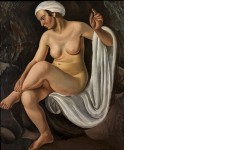TITΛΟΣ ΕΡΓΟΥΚΑΘΙΣΜΕΝΟ ΓΥΜΝΟ / LA BAGNEUSE
ΔΙΑΣΤΑΣΕΙΣ ΕΡΓΟΥΎψος : 100
Πλάτος : 81.5
ΥΛΙΚΟ ΚΑΤΑΣΚΕΥΗΣΕλαιογραφία (Λάδι σε καμβά)
ΥΠΟΓΡΑΦΗ ΚΑΛΛΙΤΕΧΝΗΚάτω Δεξιά
ΧΡΟΝΟΛΟΓΗΣΗ
ΕΛΕΓΧΟΣ ΓΝΗΣΙΟΤΗΤΑΣΔεν έχει ελεγχθεί

Provenance:
N. Mazarakis collection, Athens
Private collection, Athens
Literature:
C. Maleas, A Greek artist who Captured Paris, Kyriaki tou Vimatos newspaper, c.1927-1928 (illustrated)
E. Mavromattis, The Engraving and Painting of Dimitris Galanis 1879-1966 (doctoral dissertation) [in Greek], Athens 1983, pp. 110-111 (illustrated p. 109)
Dimitrios Galanis and his era, Cultural Center of Markopoulo, 2001, no 24 (illustrated in the exhibition catalogue)
Exhibited:
Paris, Exposition D. Galanis, Galerie La Licorne, 3-18 March 1922
Brussels, Galanis, Exposition Personnelle, Galerie du Centaure, 4-20 May 1922
A rare find, this superb painting clearly shows why Dimitrios Galanis was the first Greek to be accepted among the European avant-garde as an eminent artist. In 1920, the year he painted his Seated Nude, he exhibited along such great figures of modern art as Matisse, Vlaminck and Braque, while from 1921 on he also showed along Juan Gris, Dufy, Chagall and Picasso.
In his definitive book on the painter, art historian E. Mavromattis holds that in this painting Galanis uses his knowledge of academic principles to set a female nude, rendered with intense and harmonious curvatures, within a vague and boldly painted space, which is treated in a completely different manner than the nude form. This antithesis sums up Galanis diverse artistic heritage: on the one hand his thorough grasp of academic tenets and, on the other, his familiarity with Cezannesque and fauvist trends. I believe that this work epitomizes Galanis ideology as regards painting: to combine the immediacy of colour, as a direct optical sensation conveyed by nature, with a well-organized design structure.1
By the early 1920s, Galanis had reached maturity, was already famous in France and was preparing for shows in Brussels, London and New York. At that time his paintings made their first appearance in art auctions.2 In 1920-21 he frequently exhibited in Paris and in March 1922 he had his first one-man show, which received rave critical reviews and probably included this Seated Nude (under the title Nu or Nu Assis).3 This show established Galanis reputation as a painter and confirmed the favourable opinions already expressed on the quality of his work.4 In the show catalogues preface, André Malraux noted that the artists work has the power to stir emotions equivalent to those of a Giotto.5 Perhaps its no coincidence that some time later Galanis, thrilled with the success of his paintings, decided to formally state his dual capacity as a painter-engraver, by participating in the establishment of the Societe des Peintres-Graveurs Independants.
In one of his articles, published in 1928, A. Malraux commented on the rarity of paintings by Galanis6 noting that perceptive dealers had already started to stock his canvases and were in no hurry to sell them. The great Greek artist C. Maleas also noted that in 1928 he had visited Galanis studio in Paris to see his paintings but he had none left to show.7 On the same subject E. Mavromattis remarked: I believe that the painting production of Galanis was rather limited because he sought to make the most of analysing, structuring and realizing an idea in each painting. So I think we can interpret his nudes as manifestations of such an extreme investigative approach. The Seated Nude holding a white, sheet-like piece of fabric recalls the compositional structure in some of Delacroixs paintings.8
It should be noted that the critics of his time paid much more attention to his figurative work than his landscapes, confirming the well-established view that Galanis first and foremost concern was his love for the human form.9 According to the critical reviews he received, especially between 1920 and 1935, Galanis was considered one of the most eminent artists of his time. No other Greek artist working abroad, at least until the mid-1950s, had received the critical acclaim Galanis enjoyed during his lifetime. The French state honoured him with the highest distinctions: full professor at the Ecole des Beaux Arts in Paris and a life-long member of the French Academy.
1. E. Mavromattis, The Engraving and Painting of Dimitris Galanis 1879-1966 (doctoral dissertation) [in Greek], Athens 1983, p. 110
2. at the Hôtel Drouot (1920, 1924)
3. Mavromattis, pp. 415, 417
4. For the complete literature on Galanis see Mavromattis, pp. 533-599
5. A. Malraux, La Peinture de Galanis, exhibition catalogue, Galerie La Licorne, Paris May 1922
6. A. Malraux, A Propos des Illustrations de Galanis, Arts et Métiers Graphiques magazine, no 4, 30/3/1928, pp. 225-233
7. C. Maleas, A Greek artist who captured Paris, Kyriaki tou Vimatos newspaper, c.1927-1928
8. Mavromattis, pp. 110-111
9. Mavromattis, pp. 110, 144